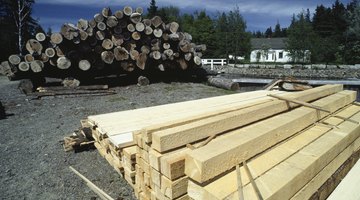Rough Vs. Resawn

Rough and resawn lumber fit into similar categories. For example, you can use both types of lumber for wood projects with similar results. To the inexperienced eye, the differences might be unnoticeable, but to the builder or professional, distinct characteristics stand out for each. For the everyday mom, if you are adding bookshelves, picture frames or decorating with wood, keeping splinters away from curious little fingers is important. Get the best of both worlds with the options rough and resawn lumber offer by understanding the way to identify differences in appearance and application.
Character Profiling
Resawn lumber characteristically contains straight saw marks due to the thin, vertical motion of a band-saw blade. Rough lumber reflects curved lines because of the circular motion of a round blade used to cut it. These distinctive line cuts define one of the differences between resawn and rough lumber. Most of the time, rough lumber consists of large beams and planks, while resawn lumber comes in flatter boards, panels or sheets. But the two disciplines are not exclusive to each other -- rough and resawn may be interchanged. Both resawn and rough lumber can have one side rough and one side resawn. Occasionally, they may have one side planed or sanded or they might remain rough or resawn on all four sides.
Color My World
Rough lumber often appears darker than resawn lumber. If the wood contains few saw lines for identification -- this could happen if both types of saws had extremely sharp blades -- the difference mostly shows up in color alone. Rough lumber represents the first step in the milling process; it gets stacked in piles and left as-is until further milling. The extra time spent waiting to mill, which can take weeks, months or longer, darkens the exposed surfaces of the wood. Resawn lumber may have one side noticeably lighter because it is typically ready to use after it is resawn. It may also have only one or two lighter sides, typically the freshly cut sides with other surfaces reflecting the darker color from exposure to the elements. For a natural wood appearance, use resawn lumber and add stain, if desired. When you want a rustic look, go with rough lumber because it offers a unsophisticated, weathered appearance.
Clean and Aggressive
Resawn lumber looks cleaner than rough lumber does. This is due in part to the thinner blades used to produce the resawn lumber. Rough lumber has a fuzzy appearance because of the aggressive blades used during the milling process. When lumber has a rough surface, it does not accept paint as well because of the large wood fibers that remain after milling. Resawn lumber has fewer fibers with a flatter surface. It more easily accepts paint and stain. Resawn lumber is cut thinner in smaller dimensions than rough lumber, making it more adaptable when used for projects that require flatter boards. Resawn lumber blends into the surface of the structure better than the fuzzy, enhanced or raised-fiber surface of rough lumber. Rough lumber can also have cracks and splits, whereas resawn lumber is typically graded higher without as many defects. Resawn offers a better choice when children have access to it, such as with a bookcase or handmade toy box. Keep rough lumber with its coarse surface up and away from delicate fingers.
Practical Purposes
For practical purposes, resawn lumber works better for shelving, exterior siding and trim. Rough lumber does a better job for large beams or thick planks. Rough lumber makes a good choice for rustic picture frames, or anywhere on your home's interior where you want to create a weathered ambiance. Resawn lumber lends itself to a finished appearance, especially when you use a high-quality piece of wood for craft or woodworking projects. Resawn lumber is easier to work with because it is available in smaller pieces. Rough lumber often requires bigger saws to cut through thicker beams and planks. Resawn lumber is often simply rough lumber, cut down to size.
Writer Bio
Specializing in hardwood furniture, trim carpentry, cabinets, home improvement and architectural millwork, Wade Shaddy has worked in homebuilding since 1972. Shaddy has also worked as a newspaper reporter and writer, and as a contributing writer for Bicycling Magazine. Shaddy began publishing in various magazines in 1992, and published a novel, “Dark Canyon,” in 2008.
Photo Credits
- DC Productions/Photodisc/Getty Images
- DC Productions/Photodisc/Getty Images
More Articles



